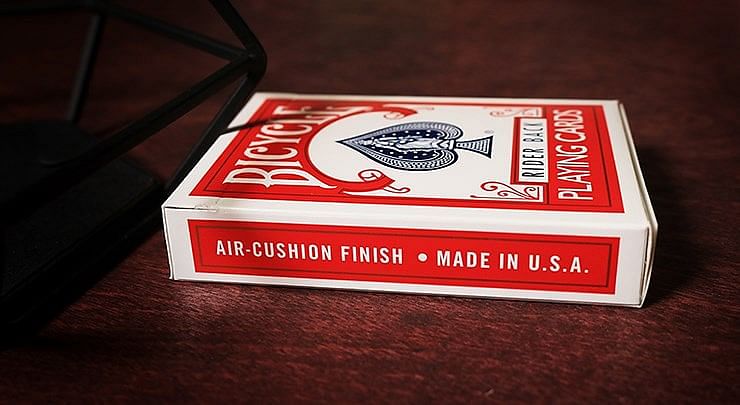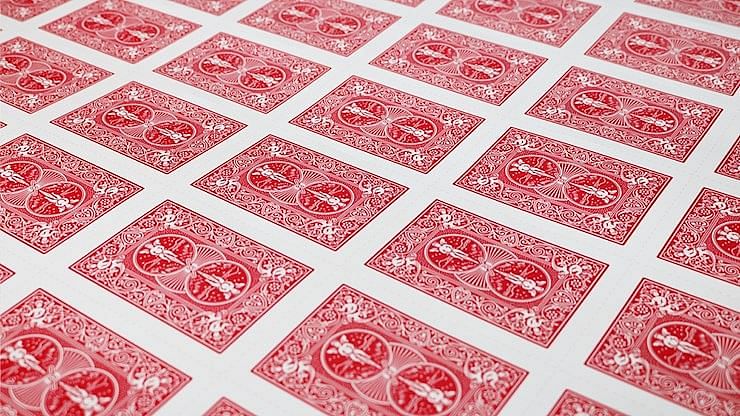How Bicycle Playing Cards are Made
Known for its signature Bicycle Playing Cards, the United States Playing Card Company (USPCC) is one of the largest producers of playing cards in the world. Join us for an exclusive look at how the USPCC continues to create high-quality decks of cards that are beloved by magicians, cardists and poker players everywhere.

History of the USPCC
The USPCC started in 1867 as Russell, Morgan & Company when A.O. Russell and Robert J. Morgan purchased the printing section of The Cincinnati Enquirer in Ohio. They began producing playing cards in 1881, eventually developing the iconic Bicycle brand and adopting their United States Playing Card Company name in 1885.
Since then, the USPCC has grown into one of the largest producers of playing cards in the world. Over the years, they have acquired smaller companies like Arcco Playing Card Company (1987) and Hoyle (2001) and now print their playing cards (including the Richard Turner Gold Seal Bicycle Cards) along with a variety of other popular brands such as Tally-Ho Playing Cards and Bee Playing Cards. They are also one of the biggest manufacturers of custom decks of cards. They even make Bicycle trick decks.
Operating out of the Cincinnati factory for decades, the USPCC eventually moved their operations to Erlanger, Kentucky in 2009.
The Secret Art of Printing
After spending more than 130 years fine-tuning their process, it’s probably not shocking to learn that the USPCC is quite discreet about how they produce playing cards. It’s similar to how you don’t see Coca-Cola eager to post their secret formula anywhere.
It’s been said that if you visit the USPCC factory, you’ll be required to sign a non-disclosure agreement. So, the following is a general overview of how USPCC playing cards are based on knowledge available to the public.
Making the Paper Stock
Most playing cards start the same way with two massive rolls of paper being run through a special laminator that sticks them together with a special opaque glue that ensures no light can shine through the cards.
However, the USPCC stands apart from the rest because they create their own unique card stock. Their signature “Air-Cushion” stock uses a special embossing technique that places small dimples on the faces of each card. These small bumps create pockets of air, allowing the cards to smoothly glide over each other. In the past, this process was done with cloth rollers covered in linen, hence the term “Linen Finish” that is occasionally used. But, today, the USPCC uses a more durable and efficient machine roller.
Printing the Playing Cards
Once the paper stock is complete, you end up with a long roll (sometimes as long as 25,000 feet) that is ready for printing. The printing process starts with a laser-etched plate. For Bicycle Playing Cards, the same digital template is used each time. However, for custom decks of cards, a new plate is constructed based on the unique design. These printing plates are mounted in the printing press on rotating cylinders which get coated with quick drying ink that is then transferred onto the paper stock as it quickly passes through the machine.
Only one roll of paper and one color can be printed at a time. If you want to add another color, the paper must go through a separate roller. This is why you start with such a massive roll of paper. The rapid web press machine used by the USPCC can print approximately 10 decks of cards every second (both the front and back!). So, by the time you’re done with your roll of paper, you end up with approximately 11,000 decks of Bicycle Playing Cards. This is also why the USPCC requires you to meet significant minimum deck requirements when ordering a custom deck of cards.
To complete the printing process, a special coating known as a “finish” is added. This seals the cards to protect against moisture and allow them to more evenly fan and spread.
Cutting the Playing Card Sheets
Once the playing cards are printed, they are sent through a finely-tuned cutting machine that divides them into “uncut sheets”. Each of these “uncut sheets” represents an entire deck of 56 cards in 7 neat rows of 8 cards. Since a standard deck of Bicycle Playing Cards features 52 cards and 2 jokers, special advertisement cards are often included to occupy these last 2 spots. In custom decks of cards, these extra cards are sometimes replaced with extra Jokers or exclusive gaff cards.
While some of the “uncut sheets” might be put aside for collectors, most of them are sent to the USPCC’s “Finishing Area” to be individually cut. Each sheet is first cut into long rows of 8 cards and then fed manually into a punch machine that “punches” each card individually at a mind-blowing rate of 350 cards per minute!

Assembling the Decks of Cards
After they are individually cut, each deck of Bicycle Playing Cards is neatly organized by a machine before being sealed in a tuck case and shrink-wrapped with plastic. They are then placed into larger boxes for distribution around the world.
Commitment to Quality
One of the biggest reasons Bicycle Playing Cards offer such consistent performance is the commitment to quality assurance from the USPCC. Specially-trained technicians closely monitor every aspect of the production process from examining the initial plates to checking for printing errors and ensuring each deck of cards is properly assembled. This is why their cards last so long and they are preferred by many magicians for magic tricks.
USPCC vs Other Companies
One of the biggest differences between USPCC playing cards and those offered by other companies is the fact that the USPCC makes its own card stock and conducts a separate embossing process to ensure consistent handling and feel across all its decks of cards. There are differences between their classic Rider backs and standard decks of cards.
Some other companies integrate embossing into the printing process and others like Expert Playing Card Company and Legends Playing Card Company will sometimes import ready-made, pre-embossed card stock from paper mills. Varying finishes means you won’t know how a deck feels or handles until you pick it up for yourself.
Some other companies also differentiate themselves by using paper with different weights in grams per square meter like 300gsm or 310gsm. There are also a variety of different glues that can be used like “black-core” or “grey-core” that impact the stiffness, flexibility or opacity of a playing card.
Why Magicians Trust Bicycle Playing Cards
As magicians and cardists, we’ve become so accustomed to handling a deck of cards that we might not realize how much technology and effort is needed to produce a quality deck of cards.
Bicycle Playing Cards continue to be one of the most popular decks of cards in the world for card tricks, sleight of hand and card games because the USPCC refuses to take short cuts with any of its playing cards. Cutting corners results in a cheap deck that handles like a stack of bricks and is useless for magic tricks or poker games.
Don’t get us wrong, other companies produce some amazing decks as well! But, the biggest selling point with Bicycle Playing Cards, or any other deck from the USPCC, is that you know exactly what you’re going to get each and every time.
If you're looking to start a card collection though, you should also check out these gorgeous custom cards, extremely rare playing cards and the best ways to store your playing cards, display your playing cards and make them last longer.
Add Bicycle Rider Back Playing Cards to cart (3.75$3.75)
Or, view more information
